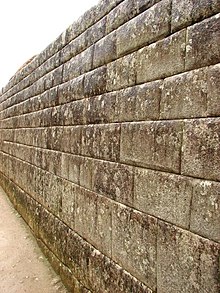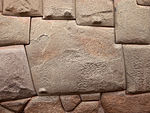Ashlar
This articlemay beconfusing or unclearto readers.(February 2021) |




Ashlar(/ˈæʃlər/) is a cut and dressedstone,worked using achiselto achieve a specific form, typically rectangular in shape. The term can also refer to a structure built from such stones.[1]
Ashlar is the finest stonemasonryunit, and is generally rectangular (cuboid). It was described byVitruviusasopus isodomumortrapezoidal.Precisely cut "on all faces adjacent to those of other stones", ashlar is capable of requiring only very thin joints between blocks, and the visible face of the stone may bequarry-facedor feature a variety of treatments: tooled, smoothly polished or rendered with another material for decorative effect.[2][3]One such decorative treatment consists of small grooves achieved by the application of a metal comb. Generally used only on softer stone ashlar, this decoration is known as "mason's drag".[4]
Ashlar is in contrast torubble masonry,which employs irregularly shaped stones, sometimes minimally worked or selected for similar size, or both. Ashlar is related but distinct from other stone masonry that is finely dressed but not quadrilateral, such as curvilinear andpolygonal masonry.[3][5]
Ashlar may becoursed,which involves lengthy horizontal layers of stone blocks laid in parallel, and therefore with continuous horizontal joints. Ashlar may also be random, which involves stone blocks laid with deliberately discontinuous courses and therefore discontinuous joints both vertically and horizontally. In either case, it generally uses a joining material such asmortarto bind the blocks together, althoughdryashlar construction, metal ties, and other methods of assembly have been used. The dry ashlar ofInca architectureinCuscoandMachu Picchuis particularly fine and famous.
Etymology
[edit]The word is attested inMiddle Englishand derives from theOld Frenchaisselier,from theLatinaxilla,a diminutive ofaxis,meaning "plank".[6]"Clene hewen ashler" often occurs in medieval documents; this means tooled or finely worked, in contradistinction to rough-axed faces.[7]
Use
[edit]Ashlar blocks have been used in the construction of many buildings as an alternative tobrickor other materials.[8]
Inclassical architecture,ashlar wall surfaces were often contrasted withrustication.
The term is frequently used to describe the dressed stone work ofprehistoric Greece and Crete,although the dressed blocks are usually much larger than modern ashlar. For example, thetholostombsofBronze AgeMycenaeuse ashlar masonry in the construction of the so-called "beehive" dome. This dome consists of finely cut ashlar blocks that decrease in size and terminate in a centralcapstone.[9]These domes are not true domes, but are constructed using thecorbel arch.
Ashlar masonry was also heavily used in the construction of palace facades onCrete,includingKnossosandPhaistos.These constructions date to theMM III-LM Ibperiod,c. 1700–1450 BC.
In modern European masonry the blocks are generally about 35 centimetres (14 in) in height. When shorter than 30 centimetres (12 in), they are usually calledsmall ashlar.
As metaphor
[edit]In someMasonicgroupings, which such societies termjurisdictions,ashlars are used as a symbolic metaphor for how one'spersonal developmentrelates to the tenets of theirlodge.As described in the explanation of theFirst Degree Tracing Board,inEmulationand otherMasonic ritualsthe rough ashlar is a stone as taken directly from the quarry, and allegorically represents the Freemason prior to his initiation; a smooth ashlar (or "perfect ashlar" ) is a stone that has been smoothed and dressed by the experiencedstonemason,and allegorically represents the Freemason who, through education and diligence, has learned the lessons of Freemasonry and who lives an upstanding life.[10]
See also
[edit]References
[edit]- ^Reich, Ronny; Katzenstein, Hannah (1992). "Glossary of Archaeological Terms". In Kempinski, Aharon; Reich, Ronny (eds.).The Architecture of Ancient Israel.Jerusalem: Israel Exploration Society. p. 312.ISBN978-965-221-013-5.
- ^ Ching, Francis D. K.; Jarzombek, Mark M.; Prakash, Vikramaditya (2007).A Global History of Architecture.Hoboken, New Jersey: John Wiley & Sons. p.759.ISBN978-0-471-26892-5.
- ^ab Sharon, Ilan (August 1987). "Phoenician and Greek Ashlar Construction Techniques at Tel Dor, Israel".Bulletin of the American Schools of Oriental Research(267). Boston: The American Schools of Oriental Research: 32–33.
- ^"The Conservation Glossary".University of Dundee. Archived fromthe originalon 2010-05-19.Retrieved2009-05-04.
- ^ Wright, George R. H. (2000).Ancient Building Technology, Vol 1: Historical Background.Technology and Change in History. Leiden, The Netherlands: E. J. Brill. p. 100.ISBN978-90-04-09969-2.OCLC490715142.
- ^"Definition of ashlar".Oxford Dictionaries.Archived fromthe originalon August 20, 2017.
- ^One or more of the preceding sentences incorporates text from a publication now in thepublic domain:Chisholm, Hugh,ed. (1911). "Ashlar".Encyclopædia Britannica.Vol. 2 (11th ed.). Cambridge University Press. p. 733.This also attests the alternative spellingsashlerandashelere.
- ^"Ashlar Masonry and its Types".The Constructor.2018-12-17.Retrieved2023-05-25.
- ^ Preziosi, D.; Hitchcock, L. A. (1999).Aegean Art and Architecture.Oxford History of Art. pp. 175–6.ISBN0-19-284208-0.
- ^"Rough and Perfect Ashlar".Masonic Lodge of Education.Retrieved15 March2015.

